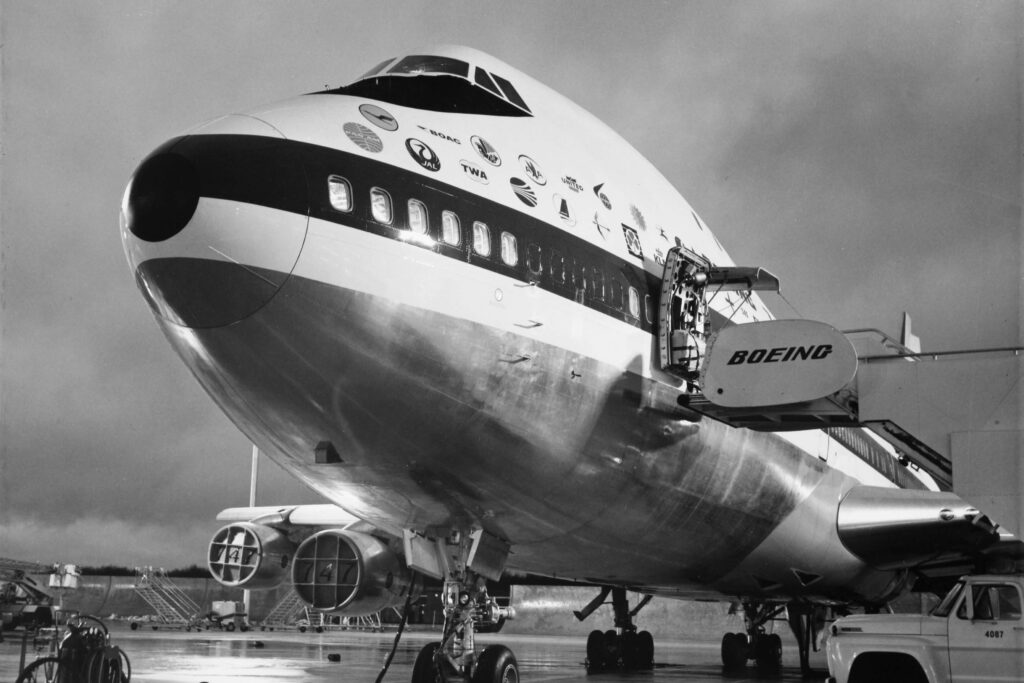On September 30, 1968, the doors of the Everett assembly plant opened. A tractor towed out a glistening new jetliner, and the sunlight slowly unveiled its Federal Aviation Administration tail number: N7470. The Queen of the Skies was introduced, symbolizing the beginning of Boeing 747 five-decade reign.
Boeing 747 first public appearance
When the Boeing 747 Jumbo Jet initially rolled out in 1968, it took the aviation world by storm. The world’s first wide-body was met with enthusiasm and loud gasps for air as the Queen made her debut in front of thousands of onlookers, press and airline representatives. The jet towered over her predecessors, as it was more than two times bigger than the 707. At the time, the Jumbo Jet was the largest civil aircraft ever produced and its first public appearance was just as grand ‒ involving flight attendants and champagne. This was two years before Boeing had set 747 to enter service.
The 26 flight attendants, who represented the 26 airlines that had already placed orders for the 747, were the first to christen the Queen. Each of them were supposed to break a bottle of champagne against the jet but were given very vague instructions about when to perform the smashing. The result was a disorganized christening with the sound of champagne bottles cracking at random intervals. Nevertheless, the ceremony evoked thundering cheers and applause from the crowd as 707, 727 and 737 made their flights overhead.
Boeing 747 enters service
The 1960s was a decade in the U.S. defined by Cold War tensions and Vietnam War chaos, social changes, and the race to put a man on the moon. At the time, the Boeing 747 program was among the largest commercial projects in the U.S. history. In turn, it received not only commercial but also political attention.
Image: White House Photo Office
On January 15, 1970, Patricia Nixon stood on a tall platform in front of the first Boeing 747 at Dulles International Airport (IAD) in Washington. The First Lady pulled a lever, releasing sprays of colored water on the Jumbo Jet that looked like champagne while a band played the national U.S. anthem. Afterwards, the president of Pan American World Airways, Najeeb E. Halaby, tried to stop the fluid by pulling the lever back, however, unsuccessfully. The colored water continued to flow until there was no more of it. The Queen was christened before her first flight.
The other side of bubbles and excitement
Nevertheless, the flashy ceremonies of champagne, First Ladies and corporate handshakes do not paint a wholesome picture of the Boeing 747 early days. The 747 christened during the above-mentioned ceremony in 1970 was not the Jumbo Jet prototype from the first appearance in 1968. The latter was preserved at the BFI 2003 Museum of flight in Seattle as a historical piece of aircraft. The Boeing 747 (registered as N748PA) that Mrs. Nixon christened was due to fly internationally from New York (JFK) to London (Heathrow) on January 21, 1970. However, due to engine overheating problems that early 747s were notorious for, the flight was delayed for seven hours until January 22.
Even before its first commercial flight, the Jumbo Jet faced serious problems during the development stages. To pull a loaded, first-ever wide-body 747 weighing around 735,000 lbs. (367.5 tons) off the ground required a great deal of thinking and technical limit pushing from aviation engineers. The early service jet was powered by the Pratt & Whitney JT-9 engine, which became a running joke, as Boeing went through 30 engines before they found four that could complete the 747’s maiden flight.
The problems continued long after the first models rolled out. People used to joke that Boeing began assembling the wide-body aircraft fleet because the rest of its models were grounded and awaiting engines. The company used a total of 87 engines for the Queen’s flight testing and 60 of them had to be scrapped or destroyed. Boeing had to work fast to amend the issue. In the end, the company changed the JT-9 so many times that some flight tests were completed with different engine versions.
But after the “roughly exciting” part, the 747 managed to forge a strong bloodline. Eventually, the manufacturer managed to rectify the Jumbo Jet’s questionable service entry. On August 31, 1973, the 747SR took flight, which had an enhanced economic design life objective of 52,000 flights in 20 years in comparison to 747-100’s 24,600 flights. From then on, the improvements continued with every model, allowing the Queen to be the largest wide-body reigning in the skies up until 2005, when Airbus introduced its first A380.
